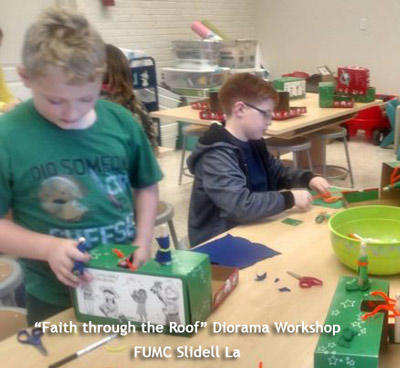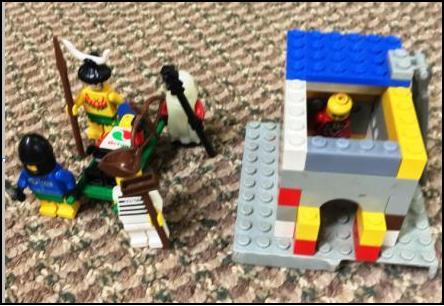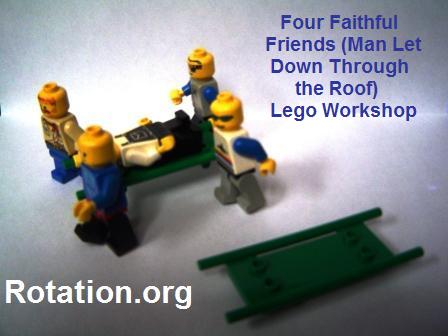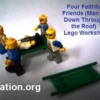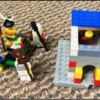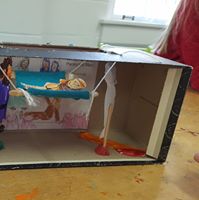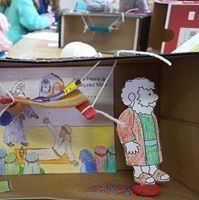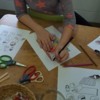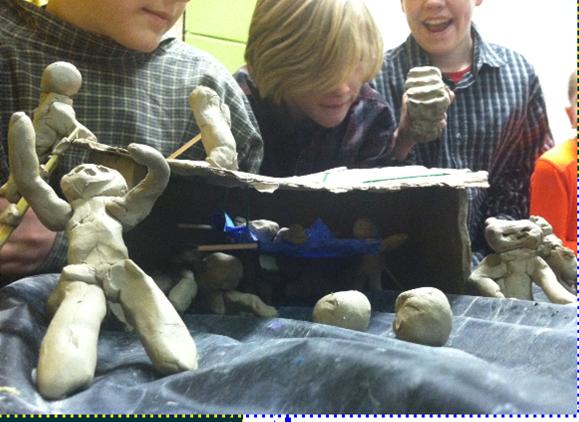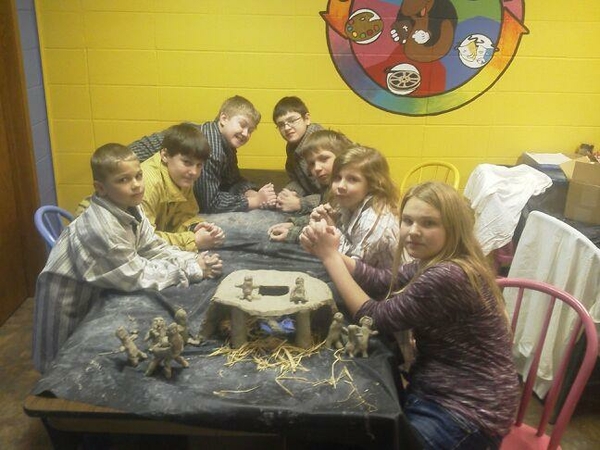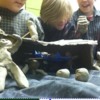Jesus and the Man Let Down Through the Roof
Art (Diorama) Workshop
(Note: this lesson plan could also be classified as storytelling or puppets)
Summary of Lesson Activities:
The children will create a storytelling kit to retell the story to parents, siblings, and friends. In retelling the story to others, the children experience another way to bring people to Christ.
Scripture Reference:
Mark 2:1-12, also Matthew 9:2-8 and Luke 5:17-26
Memory Verse:
“Let us stop just saying we love each other; let us really show it by our actions.” 1 John 3:18 (NLV)
Lesson Objectives for the art workshop
At the end of the session, the students will be able to
- Retell the story using a storytelling kit.
- Understand that telling the stories of Christ is a way to bring people to Jesus.
Teacher preparation in advance:
- Read the scripture passages and lesson plan and attend the Bible Study.
- Prepare a closing prayer.
- Learn the memory verse.
- Learn to retell the story (for hints on learning to tell a story, see Amy Crane's manual on Biblical Storytelling in the rotation.org IDEA AND LESSON EXCHANGE in the Workshop Design and Teaching Resources section under “Storytelling”
https://www.rotation.org/topic/biblical-storytelling  )
) - To our teachers at RCC: The design of this workshop is very intentional. The activities and discussion questions for this workshop were designed to meet the goals of the entire rotation and the educational objectives of the Rotation Model (tm) at River Community Church. While we feel it is important to follow the serendipitous leading of the Holy Spirit, please do not change the lesson plan without consulting a Curriculum Planning and Writing Team member.
- Check out the room before your first Sunday workshop so that you know where everything is located.
- The bin with supplies is located in the Sunday School classroom area.
- Make your own storytelling kit to use to tell the Bible story and practice using it to tell the story. Make a simple kit, not too elaborate, because the children will see your kit when you use it to tell the story during class. We usually do not show the children an example of what they are going to make so that they will use their creativity. If your example is too elaborate, some children may feel they cannot “do it right.”
- Collect shoeboxes (sample letter above). Precut holes/flaps in the boxes. Precut construction paper for mats.
Room set-up:
Set the clothes pins, markers, craft sticks, and 2”x 4” construction paper rectangles for making the story telling kits out on the tables in the art room.
Supply List:
- Shoe box for each child with a rectangular-shaped flap cut in one side (the long sides of the rectangle should be slightly longer than a craft stick and the short sides should be 2 inches long)
- 6 “old fashioned” clothes pins for each child (called “doll clothespins” or "doll pins" in craft stores)

- construction paper
- yarn or string
- modeling clay or clothespin doll stands, also available in craft stores
- optional: chenille stems (cut into short lengths to be arms for the puppets)
- markers, glue sticks, craft sticks
- books that show the architecture of the period – Bible story picturebooks or history books (check the public library)
- Memento (optional): look for stickers or something to share that will remind the children of the story
- Shepherd Time: plain or lined paper and pens, pencils, markers
Presentation
Opening-Welcome and Introductions:
Greet the children and introduce yourself. Wear your name-tag. (Remember, you are interacting with a different group of students each week who may not know you.) Make sure the children are wearing name-tags. If not, ask the shepherd to supply a temporary badge.
We had an opening prayer during the gathering time, but you may open with prayer if you feel led to do so.
Explain the purpose of this workshop: Today you are going to make a storytelling kit to help you retell the Bible story about Jesus to people you know. Telling others the stories about Jesus is a way that you can bring people to Jesus.
Scripture/Bible Story:
Before telling the story show the children how to find the passage in the Bible using your Bible. (Do not have the children do this themselves as they usually do during the Bible story time.) Review the organization of the Bible: The Bible is divided into two big parts, the Old and New Testaments. Each part is a collection of books. Each book is divided into chapters and verses. Show them that if they open their Bible in the middle, they will usually land in the book of Psalms in the OT. Point out that the book name is at the top of each page. Tell them that Mark is the second book of the New Testament and it come after Matthew. After they have found Mark tell them to find Mark 2:1-12. Some of the children may confuse chapters and verses. Show them that chapter numbers are the big ones, and also are at the top of every page (in most editions). After showing them how to find the passage, set your Bible aside and tell the story using the story telling kit you made prior to class.
Provide some background on Middle East architecture. Show pictures of buildings and towns. They will see that homes in that part of the world are very different than houses here. Because the climate is mostly dry, people do not have to worry about heavy snow or pools of water on their roofs. The houses are connected side by side and the roofs are almost flat - sometimes they have slight domes in the center. Walls are made of stone and stone steps on the outside of the houses leading up to the roof. A roof is made of a network of wood beams, branches, and mud. These roofs are very strong and when the weather is good, they are used like a deck or patio. To keep the heat out, windows are few, small and high up.” (from Creation Station (art) lesson plan, Kirk of Kildaire)
Dig-Main Content and Reflection:
Application:
Before the children move to the tables, give them instructions for making the stretcher and people. For the stretcher they will use a glue stick to put glue on one side of two craft sticks. Lay the craft sticks parallel to each other about an inch apart with the glue facing up. Lay a 2”x 4” construction paper rectangle down on the sticks with the long sides of the rectangle even with the edge of the craft sticks on each side. The ends of the sticks should be sticking out of the ends of the paper. Set the stretcher aside to dry.
To make the people, the children will use markers to draw facial features and clothes on the people. They will make four friends, one paralytic man, and Jesus.
By the time the children have made their people the stretchers will probably dry so they can tie a string to the each of the four ends of the sticks. The string should be about 12 inches long.
If time permits the children can use markers to decorate the “walls” of the shoebox house. If not, they can decorate the walls at home. When the stretcher and people are finished, give each child six small balls of modeling clay for the people to “stand in” to hold them upright. (or use the clothespin doll stands if you found them.)
Talking points while the children are working:
- Who are the people who brought us to Jesus?
- How did they bring us to Jesus?
- Who could we bring to Jesus?
- What things about this story amazed you?
- What things about this story confused you?
Reflect:
Pulling it all together (closing discussion):
Divide the children into pairs and have them take turns practicing telling the story to each other using their kits. This is a critical part of this lesson. Please keep an eye on the time and make sure it happens!
Congratulate all on a job well done! Tell them that they should tell the story to at least one more person today so it will be truly “theirs” (that is, they will have learned it by heart).
Review the memory verse.
“Scripture Simon Says”
The teacher is Scripture Simon and begins by giving the first word of the memory verse. The children respond by repeating it. Continue on in this fashion and then insert an incorrect word. The children must remain silent or they must start over. At first, the verse should be displayed for the children to follow, but after a few repetitions, remove the verse from view. The game would sound like this:
Teacher: Let
Class: Let
Teacher: us
Class: us
Teacher: stop
Class: stop
Teacher: loving
Class: (should remain silent)
Shepherd Time:
On your journal page draw a picture or write the name of the person you are going to use your story telling kit with to tell the story of the Four Faithful Friends. Also draw a picture or write the name of people who have brought you to Jesus.
This is meant to be a time of reflection and introspection. Writing about faith helps clarify lessons. In addition to the suggested activity, children may draw pictures relating to today’s scripture or memory verse, list highlights of the day’s activities, or rephrase the memory verse. The journal pages will be saved and given to the children at the end of the school year.
You may want to provide an extra activity or worksheet for children who finish their journals quickly, such as coloring sheets, crossword puzzles, word searches, games. See the Workshop Leader’s Background Notes and rotation.org for ideas.
Before noon, ask the students stop journaling for a moment and sit quietly for prayer so that they can leave when their parents arrive. Then allow them to finish journaling.
Closing:
Thank God for the people who have brought these children to Jesus and ask God to give them good recall of the story to tell to others so that they can bring people to Jesus.
Additional Suggestions:
You will need to decide how best to adjust the lesson for older and younger students. Keep the children active and involved in activity. Do what works for you and the children. Some ideas:
Older children:
Consider having them add chenille-stem arms to the clothespin puppets.
Younger Children:
- For classes composed primarily of pre-readers, show the children how to find the passage in the Bible (for example, “To find the Gospels, open the Bible in the middle and then open the second half in the middle - you should end up in Matthew, Mark, Luke, or John. Our passage is in Mark." and then have them do it. After everyone has found the passage, have them close their Bibles and listen while you read.
- Children in this age group will have a variety of abilities with small motor skills. Be ready to help before someone gets frustrated. Congratulate effort, not results.
- Leave off the string for lowering the mat. They can just pretend there are ropes (this will eliminate tangled string frustrations). You will probably want to do this for all but the very oldest group.
- Instead of having them retell the story to partners, divide the class into groups so that you have one adult for each group to “moderate” the retellings. Ask each child in the group to retell the story using his or her kit. Or if no one wants to tell to the group, lead the entire small group in a simultaneous retelling and demonstration of the story (do this several times if no one wants to solo).
Resources and Credits
- Kosmachuk, Joan Dower; Hide God’s Word in Young Hearts; Standard Publishing, Cincinnati, Ohio, 1990.
- From an idea posted by Neil MacQueen rotation.org.
- From an idea posted at rotation.org by member Catherine, Kirk of Kildaire.
- Books that show Middle Eastern Architecture: these and more are available at the library.
- Tubb, Jonathan N. Biblelands. New York: Knopf, 1991. (Page 6 has small picture of village near Hebron)
- Great People of the Bible and How they Lived. Pleasantville, NY: Readers Digest, 1974. (Page 306 shows an excellent rendering of a small village of clustered houses with people on rooftops.)
This lesson was written by Jamie Senyard for River Community Church
Prairieville, Louisiana.
Copyright 2003 Jamie Senyard. Posted by Amy Crane. Permission granted to freely distribute and use, provided the copyright message is included.
A representative of Rotation.org reformatted this post to improve readability.





